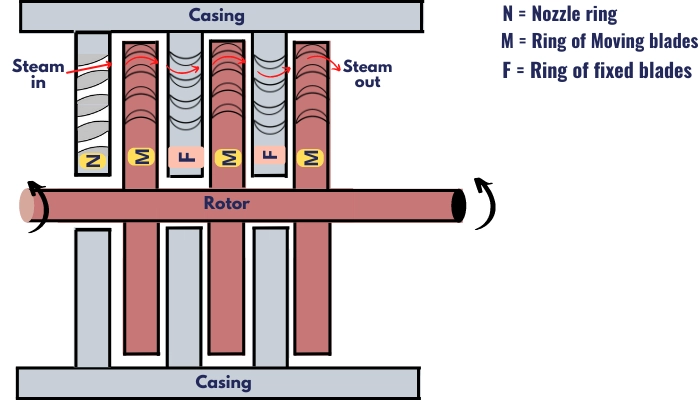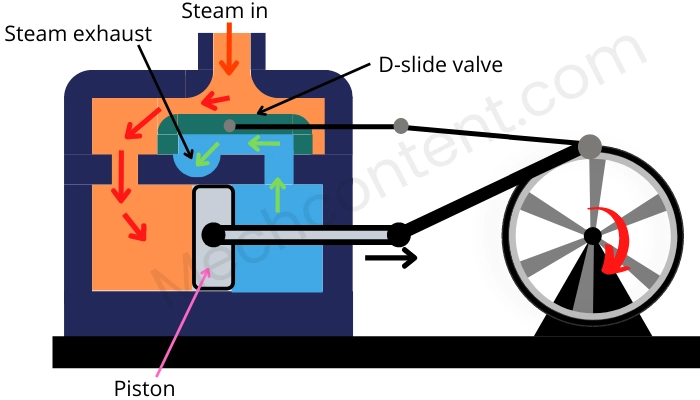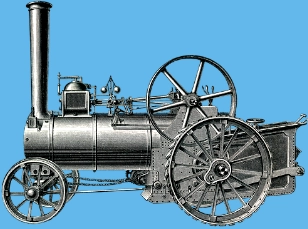One of the vital distinguishing point between the steam turbine vs steam engine is that in the steam turbine, the steam is expanded into the sets of nozzles, fixed blades, and moving blades to get the work output while in the case of the steam engine, the steam is expanded into the piston-cylinder assembly to get the work output.
So, let us look at how a steam turbine differ from a steam engine in detail, along with a quick introduction to each of them.
Steam turbine:

The steam turbine is the rotating machine that extracts the pressure energy of the steam and converts it into the mechanical power output at the rotor shaft.
In the steam turbine, the pressure of the steam is dropped to rotate the blades of the turbine.
The steam turbine mainly consists of the following components:-
- Ring of nozzles
- Ring of moving blades
- Ring of fixed blades
It is mostly used for electrical power generation as well as it is also used to run the different industrial equipments and locomotives.
Steam engine:

The steam engine is the reciprocating device that converts the pressure energy of the steam into the reciprocating motion and further converts it into the rotary motion.
The main components of the steam engine are piston, cylinder, D-slide valve, connecting rod, crank, etc.
As shown in the above figure, the typical steam turbine consists of a double-acting piston cylinder. In that, the steam is alternately supplied to each side of the double-acting cylinder with the help of a D-slide valve. Thus the piston reciprocates into the cylinder of a steam engine.
The reciprocating motion of the piston is further converted into the rotary motion by using a crank and connecting rod.
The steam engine was used in old locomotives and boats.

Difference between steam turbine and steam engine:
| Sr. No | Steam turbine | Steam engine |
|---|---|---|
| 1 | The steam turbine is a rotary device that converts the high-pressure energy of the steam into turbine work. | The steam engine is a reciprocating device that converts the high-pressure energy of the steam into output work. |
| 2 | Steam is expanded over the set of nozzles, set of fixed blades and moving blades. | The steam is expanded in the piston and cylinder. |
| 3 | The steam moves axially. | There is no fixed direction for the steam movement. |
| 4 | The kinetic energy of the steam is used to rotate the blades of a steam turbine. | The pressure energy of the steam is used to move the piston of a steam engine. |
| 5 | The basic components of the steam turbine are nozzles, moving blades, fixed blades, rotor, etc. | The basic components of the steam engine are piston, cylinder, D-slide valve, connecting rod, crankshaft, etc. |
| 6 | The steam turbines are mostly used at the power plants to rotate the generator. | The steam engines were used in ships and early time locomotives. |
| 7 | The energy of the steam is directly converted into rotary motion. | The energy of the steam is firstly utilized to get the reciprocating motion of the piston and then it is converted into the rotary motion. |
| 8 | The steam turbines are well balanced. | The steam engines are not well balanced because of the reciprocating mass. |
| 9 | The steam turbine is suitable to meet the high power requirements. | The steam engine is not suitable for high power requirements. |
| 10 | It has a lower maintenance cost. | It has a higher maintenance cost. |
| 11 | It operates at a higher speed. | It operates at a lower speed. |
| 12 | It has higher thermal efficiency than the steam engine. | It has lower thermal efficiency in comparison with the steam turbine. |
| 13 | It creates fewer vibrations. | It creates higher vibrations. |
FAQs:
-
Which is more efficient steam turbine or steam engine?
The steam turbine is more efficient than the steam engine.
-
Which is used in power plant steam engine or steam turbine?
The steam turbines coupled with the generators are used in power plants for power generation.